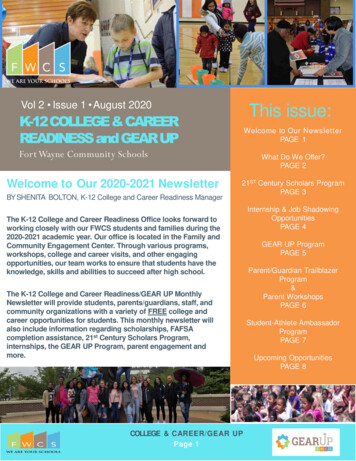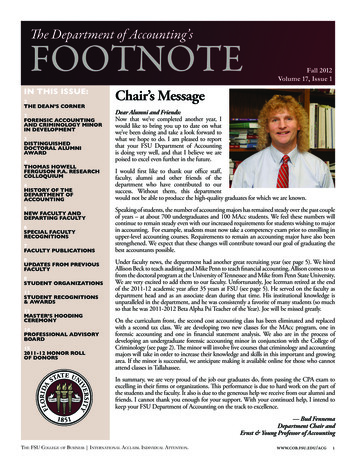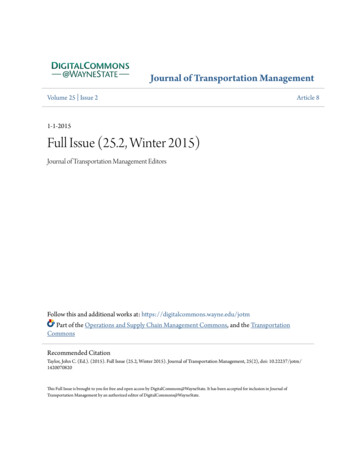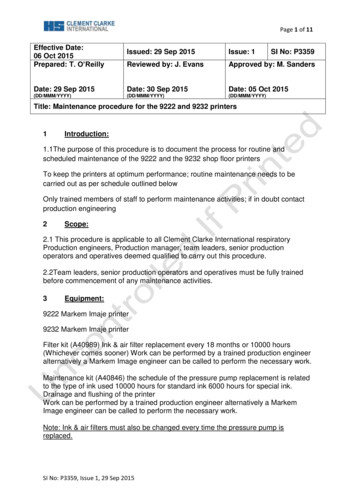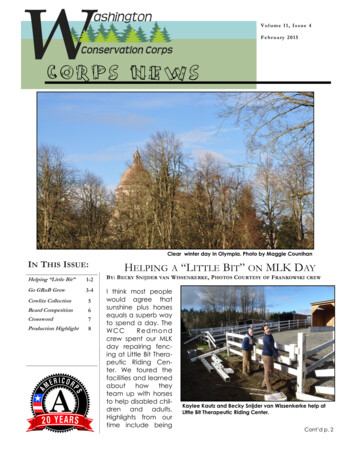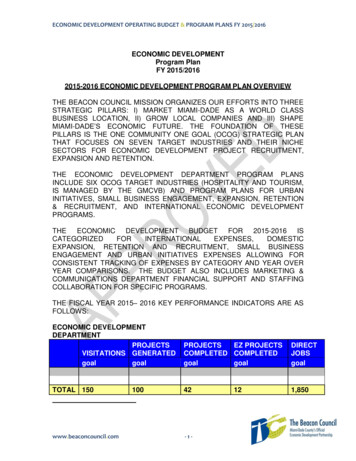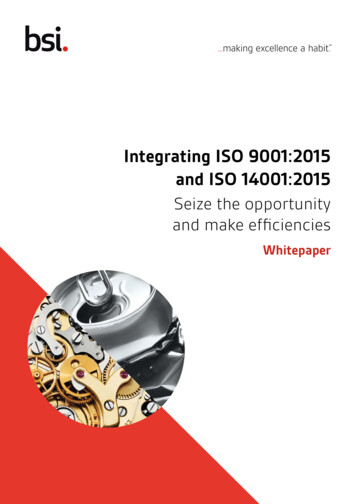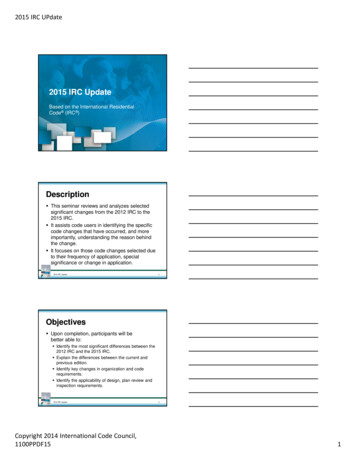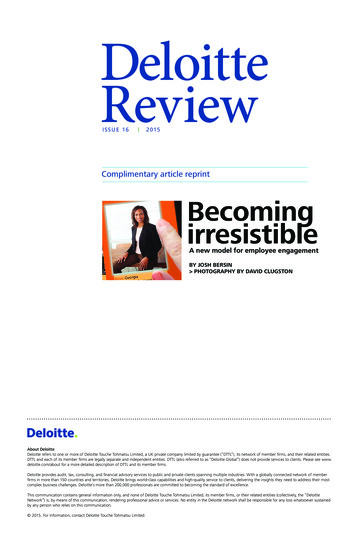
Transcription
I S S U E 16 2 015Complimentary article reprintBecomingirresistibleA new model for employee engagementBY JOSH BERSIN PHOTOGRAPHY BY DAVID CLUGSTONAbout DeloitteDeloitte refers to one or more of Deloitte Touche Tohmatsu Limited, a UK private company limited by guarantee (“DTTL”), its network of member firms, and their related entities.DTTL and each of its member firms are legally separate and independent entities. DTTL (also referred to as “Deloitte Global”) does not provide services to clients. Please see www.deloitte.com/about for a more detailed description of DTTL and its member firms.Deloitte provides audit, tax, consulting, and financial advisory services to public and private clients spanning multiple industries. With a globally connected network of memberfirms in more than 150 countries and territories, Deloitte brings world-class capabilities and high-quality service to clients, delivering the insights they need to address their mostcomplex business challenges. Deloitte’s more than 200,000 professionals are committed to becoming the standard of excellence.This communication contains general information only, and none of Deloitte Touche Tohmatsu Limited, its member firms, or their related entities (collectively, the “DeloitteNetwork”) is, by means of this communication, rendering professional advice or services. No entity in the Deloitte network shall be responsible for any loss whatsoever sustainedby any person who relies on this communication. 2015. For information, contact Deloitte Touche Tohmatsu Limited.
146BECOMING IRRESISTIBLEDeloitte ReviewD E L O I T T E R E V I E W. C O M
BECOMING IRRESISTIBLEBecomingirresistibleA new model for employee engagementBY JOSH BERSIN PHOTOGRAPHY BY DAVID CLUGSTONAfter decades of corporate discourse about the war for talent, it appears thatthe battle is over, and talent has won. Employees today have increased bar-gaining power, the job market is highly transparent, and attracting top-skilledworkers is a highly competitive activity. Companies are now investing in analytics tools to figure out why people leave, and the topics of purpose, engagement,and culture weigh on the minds of business leaders everywhere.D E L O I T T E R E V I E W. C O MDeloitte Review147
148BECOMING IRRESISTIBLEOur research suggests that the issues of “retention and engagement” have risento No. 2 in the minds of business leaders, second only to the challenge of buildingglobal leadership.1 These concerns are grounded in disconcerting data: Gallup’s 2014 research shows that only 13 percent of all employees are“highly engaged,” and 26 percent are “actively disengaged.”2 Glassdoor, a company that allows employees to rate their employers, reportsthat only 54 percent of employees recommend their company as a placeto work.3 In the high-technology industry, two-thirds of all workers believe they couldfind a better job in less than 60 days if they only took the time to look.4 Eighty percent of organizations believe their employees are overwhelmedwith information and activity at work (21 percent cite the issue as urgent),yet fewer than 8 percent have programs to deal with the issue.5 More than 70 percent of Millennials expect their employers to focus on societal or mission-driven problems; 70 percent want to be creative at work; andmore than two-thirds believe it is management’s job to provide them withaccelerated development opportunities in order for them to stay.6The employee-work contract has changed: People are operating more like freeagents than in the past. In short, the balance of power has shifted from employerto employee, forcing business leaders to learn how to build an organization thatengages employees as sensitive, passionate, creative contributors. We call this ashift from improving employee engagement to a focus on building an irresistibleorganization.TIME FOR A CHANGEOne of the issues we must address is the aging idea of an employee engagementsurvey. While such measures of engagement have been used for years, orga-nizations tell us they aren’t providing modern, actionable solutions.Consider the typical process: Companies deploy annual surveys to benchmarka company’s level of employee satisfaction from year to year. Most use vendor-provided surveys that claim to be statistically validated ways of measuring engagement.The marketplace of survey providers, which is around 1 billion in size, is largely staffed by industrial psychologists who have built statistical models that correlateturnover with various employment variables. The pioneer in this market, Gallup,promotes a survey of 12 simple factors that statistically predict retention.7 Othervendors have their own models, many focused on the characteristics of leadership,Deloitte ReviewD E L O I T T E R E V I E W. C O M
BECOMING IRRESISTIBLEmanagement, career opportunities, and other elements of the work environment.While none of these models are “wrong,” companies tell us the surveys don’tprescribe actionable results. In a recent survey among 80 of the most advanced users of engagement surveys, only half believe their executives know how to build aculture of engagement.8 Among the broader population, the percentage is far lower.Consider the radical changes that have taken place at work: Employees operate in a transparent job market where in-demand staff find new positions in theirinboxes. Organizations are flattened, giving people less time with their direct managers.9 Younger employees have increased the demand for rapid job rotation, accelerated leadership, and continuous feedback. Finally, the work environment ishighly complex—where we once worked with a team in an office, we now work24/7 with email, instant messages, conference calls, and mobile devices that haveeliminated the barriers between our work and personal lives.These changes to the workplace have altered the engagement equation, forcing us to rethink it. For example, a well-known pharmaceutical company foundthat its executives and scientists in China were leaving the company at an alarmingrate. The annual engagement survey provided no information to help diagnose thisproblem. By running a statistical analysis on all the variables among these departing high-potential workers, the company realized that in China, unlike other partsof the world, people were expecting very high rates of compensation increase everyyear. The job market there was highly competitive, so people were being poachedbased on salary progression alone.Today more and more companies are deploying analytics solutions to predictretention, correlating factors such as compensation, travel schedule, manager, anddemographics to understand why certain people are less engaged than others.10 Butthe answers are hard to find: High-technology companies, for example, throw benefits at employees to see which ones stick—unlimited vacation, free food, healthclubs, parties, stock options, and fun offices are common. Do these all result in highengagement? Most companies can’t really tell you.So what matters today? How can we create an organization in today’s work environment that is magnetic and attractive, creates a high level of performance andpassion, and continuously monitors problems that need to be fixed?MAKE WORK IRRESISTIBLEOur research suggests that we need to rethink the problem. There are threeissues to address:1. Companies need to expand their thinking about what “engagement” meanstoday, giving managers and leaders specific practices they can adopt, andD E L O I T T E R E V I E W. C O MDeloitte Review149
150BECOMING IRRESISTIBLEholding line leaders accountable. Here we suggest 5 elements and 20 specificpractices.2. Companies need tools and methods that measure and capture employeefeedback and sentiment on a real-time, local basis so they can continuouslyadjust management practices and the work environment at a local level.These tools include employee feedback systems as well as data analytics systems that help identify and predict factors that create low engagement andretention problems.3. Leaders in business and HR need to raise employee engagement from an HRprogram to a core business strategy.A REFRESHED MODEL FOR ENGAGEMENTAfter two years of research and discussions with hundreds of clients, we uncovered five major elements (and 20 underlying strategies) that work together tomake organizations “irresistible.” These 20 factors fit together into a whole system ofengagement in an organization (figure 1), one that is held together through culture.Figure 1. The simply irresistible organization What we have learned: Five elements drive engagementMeaningfulworkHands-onmanagementPositive workenvironmentGrowthopportunityTrust inleadershipAutonomyClear, transparentgoalsFlexible workenvironmentTraining andsupport on the jobMission andpurposeSelect to fitCoachingHumanisticworkplaceFacilitated talentmobilityContinuousinvestment inpeopleSmall, empoweredteamsInvest inmanagementdevelopmentCulture ofrecognitionSelf-directed,dynamic learningTransparency andhonestyTime for slackModernperformancemanagementInclusive, diversework environmentHigh-impactlearning cultureInspirationA focus on simplicityGraphic: Deloitte University Press DUPress.comA note about compensation and benefitsMost studies show that compensation is an important factor in employee satisfaction. Research by Aon Hewitt, for example, shows that it ranks among the topDeloitte ReviewD E L O I T T E R E V I E W. C O M
BECOMING IRRESISTIBLEfive drivers (but is not number one).11 In this article, we do not discuss compensation because much research shows that pay is a “hygiene factor,” not an “engagement factor.” In other words, in most cases if compensation is not high enough,people will leave—but increasing compensation does not directly increase engagement (with certain exceptions).One organization we studied told us that among the highest-potential employees, the organization could directly correlate pay increases with retention—butamong the remaining 90 percent of the workforce, compensation simply had to becompetitive and fair within job families. Our discussions with clients confirmedthat once pay is competitive and fair, the 20 issues we discuss in this paper have amuch greater effect.1. Make work meaningfulThe first and perhaps most important part of employee engagement is jobperson fit. We need to make sure jobs are meaningful, people have the tools andautonomy to succeed, and that we select the right people for the right job. This isanything but a simple undertaking.Nearly every job has been changed and often transformed by technology, andwe constantly look for ways to do more with less. Well-run companies constantlylook at the work they do, trying to find ways to outsource more to technology andproduce more output with less expensive human input. Despite these pressures toimprove productivity, research shows that when we enrich jobs, giving people moreautonomy, decision-making power, time, and support, the company makes moremoney.12Psychologist Daniel Pink writes that people are driven by “autonomy, mastery,and purpose.”13 Individuals crave work that lets them leave a unique fingerprint ona finished product. Zeynep Ton, a Massachusetts Institute of Technology professor,in her book The Good Jobs Strategy shows that retailers like Whole Foods, Costco,UPS, and Mercadona deliver higher profitability per employee by giving their employees above-average wages and greater control over their jobs.14 The idea of “lowering the cost of labor” to save money backfires because people simply become lessproductive as their workload goes up.At Mercadona and Costco, for example, stores are staffed by people cross-trainedto handle many positions: They manage cash registers, stock shelves, rearrange thestore, develop promotions, and manage others. The result is both a set of highlyempowered teams that have the training and freedom to be both autonomous andproductive as well as above-average retention and engagement rates.As we design jobs to be meaningful, we must also carefully select the right person for each job. Fewer than 40 percent of all hiring teams use any form of formalD E L O I T T E R E V I E W. C O MDeloitte Review151
152BECOMING IRRESISTIBLEprehire assessment: Most managers look for relevant experience, college credentials, or GPA.15While these seem to be sound criteria for success, when organizations study thecharacteristics of high performers, they find that other “fit factors” actually drivesuccess and happiness on the job.16 A movie theater company found, for example,that theater employees who drive the highest levels of customer satisfaction andconcession sales are not those with good grades or strong academic experience butrather people who “like to have fun” and “love to serve others.” An insurance company found that the best salespeople were not those from top schools but ratherthose who had experience in the auto industry and no typos on their resumes.When we hire people who fit, they perform well, and they love their work.17The concept of culture has also become an important part of job fit. Zappos, acompany that prides itself on culture as strategy, uses its 10 core values to assesspeople for cultural fit in the early stages of the application process.18 By getting toknow candidates well (through online and phone meetings) before people evenapply for jobs, Zappos can assess fit and help people decide if they should even apply for a job. This type of assessment has helped Zappos maintain a high level ofengagement, low turnover, and its place among one of the best customer-serviceproviders in online retail.19Research also shows that meaningful work takes place in small teams. Jeff Bezos,the CEO of Amazon.com, is reported to have said that “if there are more than twopizzas in the room for lunch, then the team is too big.” Small teams feel empowered,they make decisions faster, and the people get to know each other and can lend ahand wh
152 BECOMING IRRESISTIBLE prehire assessment: Most managers look for relevant experience, college creden-tials, or GPA.15 While these seem to be sound criteria for success, when organizations study the characteristics of high performers, they find that other “fit factors” actually drive success and happiness on the job.16 A movie theater company found, for example, that theater employees .

